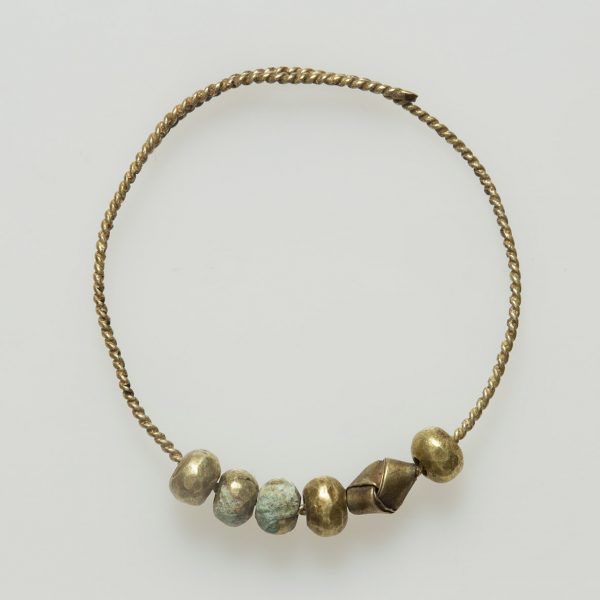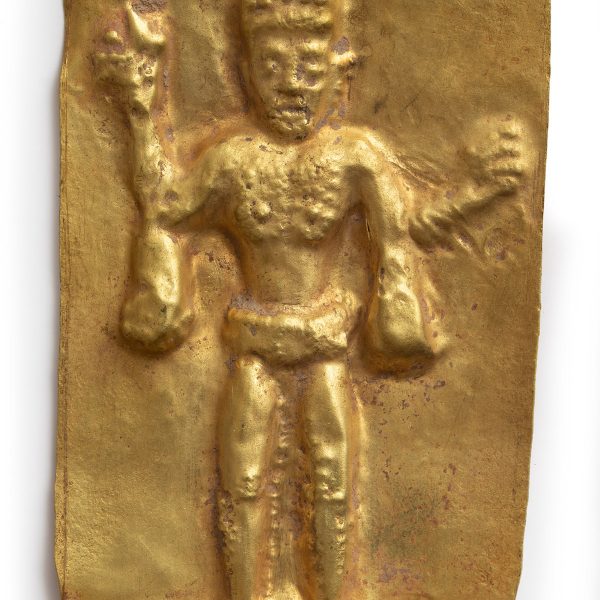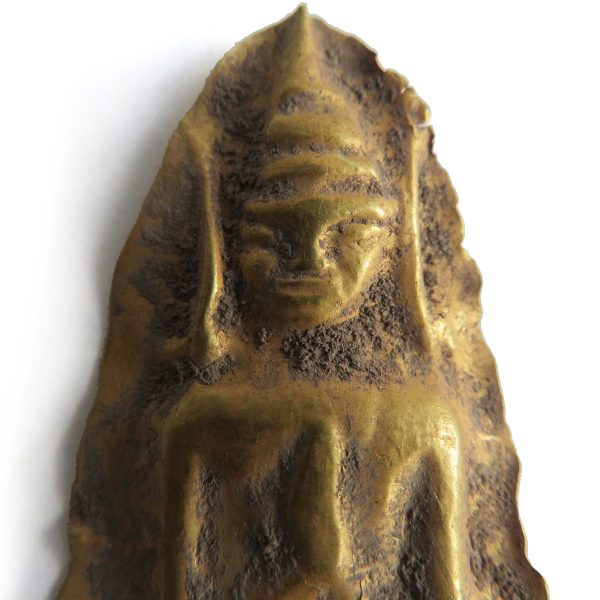Volume 1, Issue 1, March–April 2020.
Ancient Gold
in Cambodia
Prof. Dr. Claude Jacques †
It seems that ever since the realization that gold, the shiny yellow element that attracts so much greed around the world, remained unaltered and unblemished, man has used it to create objects of beauty, in particular jewellery or accessories, using either solid gold or An alloy with some other metal. It is known as the ‘beautiful metal’ in Sanskrit, where one of its most frequent names is suvarna, [the one with the beautiful colour], while silver, another precious metal, is in the same language called rúpya, [the beautiful (metal)]. Since it is scarce, gold has also become what one now calls a ‘safe haven’, which it has been for a long time. More consideration has been given to its worth in weight than to the form in which it is presented: it has been made into ingots of varying weights, and this has made it all the more fascinating. Gold has become the prerogative par excellence of gods, of kings, and of the rich.
With gold, one could initially display one’s wealth or augment it by buying the means of production, but gold per se could not produce wealth because its malleability renders it unsuitable for practical use. Certainly, it has been used for commerce, but its value is so great that it is inconvenient for everyday purchases. It has been rather reserved for international and other trade and, furthermore, it is doubtless not without pertinence or interest to note that while the literate have used the Sanskrit words to refer to gold, the Khmer words for gold (mãs) and silver (prãk) are the same as in Cham and Malay in which they seem to have been borrowed, which attests to commercial exchanges between these Southeast Asian countries.
However, from a historian’s point of view, gold has one serious defect: it is easy to melt it in order to put it to a new use. Imperishable and susceptible to being refashioned repeatedly, ancient objects have thus vanished to reappear in other forms each time that their owners deemed it to be useful to make the change. It is actually luck that leads us to discover some of them, whether they have been lost (the most frequent case being that of small objects such as rings) or whether a fortunate explorer happens upon ‘treasure trove’ hidden for some reason and forgotten for centuries. In this latter case, the discoverer, if he can, avoids publicizing his discovery, and the historian is frustrated. Like all peoples of the world, the Khmers liked gold and its characteristics, and profited from its malleability, refashioning indefinitely the objects they had made initially. As happened elsewhere, they hid their gold in times of crisis, and it was often forgotten and sometimes rediscovered.
Evidence of the presence of gold in Cambodia
The oldest evidence of gold in Cambodia is to be found in the excavations conducted by Louis Malleret between 1938 and 1945 in the region of the Mekong Delta and principally on the site of Oc-Èo, an international port.1 This researcher managed to uncover a good number of pieces of goldsmith work: flowers, small chains, pendant rings and bands totalling 1120 grams, to which, it must be noted, we should add “all the products of clandestine excavations that escaped [his] notice”. He also found evidence of workshops, with goldsmith’s hammers and punches, etc. These objects are certainly difficult to date accurately, but we know that the Oc-Èo civilization dates more or less from the Christian era, one or two centuries before the onset of Indian civilization. It seems that from this epoch, the techniques of usage – alloy or inlay (the quantities are such that one is tempted to speak particularly of this procedure, without obvious evidence) had been mastered.
In contrast, we have heard of the work recently carried out on the highway at the ancient village of Angkor Borei, in Ta-Kèo province, in the south of Cambodia.2 The villagers there were surprised to discover among the excavated rubble a mass of ancient objects, of which a considerable number were gold items, which they seized without any further ado. It is a pity that no inventory could be made of this veritable treasure. In reality, it is widely acknowledged that clandestine excavations have become the norm: by definition, it is difficult to assess with any accuracy the extent of what is then discovered, even if, by chance, one has knowledge of one of the objects derived from such excavations. In any case, this could give no more than a glimpse of the ancient wealth: it could speak only of lost or possibly hidden objects, the majority of objects in gold having been transformed.
It seems that numerous coins, sometimes in gold but mainly in silver, known as ‘of the sun’, which were discovered both at Oc-Èo and at Angkor Borei, complete or broken into two or four pieces, were not local in origin, but rather had come from abroad, from Mon or Pyu, or even Cham and Malay lands. They bear no indication of their value and must have been used according to their weight, which explains why they were then broken into two or four. In the inscriptions, however, there is never any evidence of exchange for cash, there was only bartering, even for land. It must therefore be assumed that the Khmers either did not know or did not want a monetary system, because it would be difficult to understand the Khmers abruptly abandoning a system they could have used for several centuries. It can also be noted that during the construction of monuments and in all likelihood from the outset, ritual required the placing of what were known as ‘foundation’ deposits at various levels of the temple in specially designed blocks, which as well as a number of semi-precious stones contained small leaves of gold, often with a hammered design, or even some letters. The most important of these deposits can be found beneath the pedestal of the idol: probably after what is known as the abandoning of Angkor and the desertion of the temples, clandestine excavators wanted to search for the small leaf of gold, which in fact never exceeded a few grams.
Thus, after a lot of often superhuman work, many pedestals and statues were destroyed for a truly meagre profit. Many of these thin leaves have been found during the disassembly of temples prior to restoration. In all, they represent only a very modest quantity of this precious metal. What do written documents show us? The most ancient information on Cambodia is found in the Chinese dynastic annals, and it is there that the first mention of gold in Cambodia is to be found. In reality, these annals contain only a few mentions of gold. However, we learn through the Nan Qishu (Nan Ts’i chou) that in 484 King Kaundinya-Jayavarman sent the emperor of China “a chiselled gold image of the seat of the king of dragons”,3 although we know neither what this object actually was nor its weight, this sole mention must be borne in mind. According to the same document, the king promises a gift of five golden bhāra, which, as we shall see later, represents something between 250 and 1500 kg of the metal! Later, the same book tells us that “the inhabitants of Funan create rings and bracelets in gold, and tableware in silver”. (4)
We know that the main written source of information about Cambodia is to be found in inscriptions. First and foremost, it is important to remember that inscriptions are always religious documents that, in Sanskrit, celebrate the gods and their benefactors (particularly those who installed the gods) and in Khmer, they make lists of things certain benefactors have given to these gods; moreover, there are many temples without inscriptions: thus these texts paint only a partial picture of society and its wealth.
Focussing on the inscriptions alone, it would seem that little gold was offered in the period known as the pre-Angkorian (5th–9th centuries), we often come across mentions of gold, suvarna or mās, but this word has several meanings: above all, it happens to be a proper noun, or even a noun for a measure of weight through confusion with māsa, a noun for weight in Sanskrit; in reference to the metal, the word actually appears only three times. We can cite an inscription bearing the date 673,5 which mentions the gift to god of a diadem in gold and a kośa, designating the sheath covering the linga, mentioned far more frequently in Champa than in Cambodia. It is certain that in any case gold is not absent because one of these texts specifies that “those who steal gold … shall go to hell with their ancestors and their grandfather, their children, and their grandchildren”.6
The pre-Angkor inscriptions, for an unknown reason, give only a vague idea of the presence of gold in the Khmer lands. With the inscriptions of the ‘Angkor period’ (9th–13th centuries), references to gold become more frequent, but they mostly are padded out with long lists of gifts from kings or grand dignitaries to the gods. From 880, engraved onto the large stele of Prah Kô,7 we find a list (not enumerated) of offerings from the King Indravarman I (877 to before 889) to the gods of this temple, which however confuses the objects in gold with those in silver: vases, cups, boxes, mirrors, etc., “in gold and in silver”: but the proportion in which these metals were used is not specified. The reverse of this stele, engraved during the reign of Yaśovarman I, son of Indravarman, there is a list of his offerings, including, alongside numerous servants, various utensils in gold and silver used in worship.
Later, we will see a long inscription8 dating from the reign of Jayavarman V (968–1000), which furnishes an impressive list of various objects in gold and silver emanating from a great dignitary, Divakarapandita, a Brahman who came from India, spouse of the king’s sister; there is a detailed description of the ornaments of each god, followed by all the religious accessories given to these gods. Here is the list of finery and jewellery offered to the principal god of the temple, called Dvijendrasvāmi, a figure of Vishnu (the meaning of the words left in italics is not known): “1 diadem with a ruby; one club; 2 pikes with 2 stones; 2 pendant earrings; 1 conch; 1 trident; 4 bracelets; 1 cuirass [covering] the back and front, with 10 stones; 1 garment (covering) back and front; rings [with a number of] 1 par 3 lā; 2 forearm bracelets with 77 sapphires; 7 cuni [with?] 184 pearls; 1 club; 1 pedestal covering; 2 ankle rings with stones [with a number of] 3 par 2 lā, 1 ring with 1 jewel, 1 dagger, 1 ensemble of 158 pearls, all this ensemble is in gold.
“1 garland in silver; 8 flowers in pendants with 23 stones, 1 complete covering of a jār, a complete covering for run-off channels [of a pedestal], 2 coverings for serpent; all this ensemble is in silver [representing]) the fee for a place.”9 All this concerns the god and its statue, but after having mentioned each of the gods, the list continues with numerous accessories for worship sometimes in gold, as well as musical instruments, amongst which it should be noted there is a lute (kinnara) covered in gold. The inscriptions show us that gold was everywhere. Some of this gold was given to the gods, but one often finds that the king offered his grand dignitaries golden palanquins – probably this referred to the coverings, of which a good number have been found in bronze without any gold – and banners for staffs in gold, jewels, diadems, earrings, bracelets, rings, etc.
It is difficult to know if the statues were in solid gold or gold-plated bronze: those that have come down to us are few in number and are only plated, but they cannot be assumed to be the norm. From the beginning of the 7th century, there is mention of the golden linga of Sambor Prei Kuk: was it solid gold or gold plated? And this is certainly not the only example. Much later, the magnificent giant statue in bronze from East Mebon was certainly gold-plated. And fortifications? Beginning from the end of the 10th century, the inscriptions mention a “golden mount” (svarnādri) or synonyms, a “mount with a golden point” (hemaśrngagiri) which was very intriguing.10 The image is assuredly that of the mountain of Indian cosmology at the centre of the world, Mount Meru, to which this name is sometimes given that is represented materially by the ‘temple-mountain’ located at the centre of the Khmer world. Should this be taken literally? Given that this name was used for more than a century and actually seems to designate three different monuments – Ta Kèv, Phimeanakas and Baphuon, one might wonder whether there was an insistence on a characteristic that began then and which was manifested in covering the principle tower of these monuments in gold: to begin with, only the tip was covered in gold (śrnga) often a triśūla in iron, standing at the summit of the tour, then there was a move to cover the whole of the tower, as indicated in the texts on the central sanctuaries in Ta Prohm and Prah Khan.
The Baphuon, dubbed the “tower of bronze” by Zhou Daguan, has since lost its main sanctuary, to the point where we no longer know what it looked like. It has often been imagined to have been in wood: one might even go so far as to suppose that this wood supported bronze plaques, which have since apparently disappeared, but we cannot know whether they were covered in gold.
Angkor Wat was at least partially covered in gold, but probably not externally: the evidence of the archaeologist George Groslier cannot be dismissed: ‘I consider it certain,’ he writes, ‘that the friezes, lintels, the moulding of the doorways, Apsaras, sculptures of columns and piers of the transverse gallery in Angkor Wat and the bass-reliefs of this monument were covered in gold leaf on a foundation of resin, sometimes black and sometimes red.’11 Indisputably, the celebrated Chinese Zhou Daguan mentions no gold, but, the succinct description he gives of the monument makes uncertain whether he ever actually entered this temple.
The large steles of Ta Prohm and Prah Khan, at the end of the 12th century, however, have the advantage of stating the quantities of gold used in these temples, in separating on the one hand the gold used for jewels and the accessories for worship, and on the other hand the gold used in plating. They allow us to understand that in these large temples, the central sanctuaries were completely covered in gold-plated bronze, in the interior and the exterior: everyone has noted the holes made at regular intervals on the interior vertical surfaces of the walls of these sanctuaries, which were presumably put there to peg the plaques of bronze into; also, the exterior walls have clearly been neglected in preparation for being plated, or again, their sculptures have been destroyed in order to make it possible to place bronze plaques there. Indeed, this operation (created by moulding of plaques of bronze, plating them with gold and placing them in position) must have been a mammoth task. Since which point have ‘plates’ been put in position? Similar openings happen to have been noted in the internal walls of the central sanctuary of the larger temple of Prah Khan [of] Kompong Svay, which seems to date to the end of the 10th century. Although it is true that these holes could have been drilled later at the time when the temple was completed in the 12th century.
The origin of the gold of Cambodia
Where did all this gold come from? At the end of the 13th century, the Chinese writer Zhou Daguan states categorically: “This country produces, I believe, neither gold nor silver; what is most valued is Chinese gold and silver”.12 This remark is important, even if one suspects that it contains some exaggeration. We might suppose that Cambodia had some resources in gold, albeit not particularly abundant ones, without a genuine mine and collected by panning, and that the large quantities recorded arrived there from abroad.
One particularly interesting and exceptional document bearing the date 925, has recently come to light13 that lists the tribute that the province of Lingapura (south of today’s Laos) had to send each year to the king, a tribute that he offered to the famous temple of Lingapura, hence his mention in an inscription. From this long list, one can tell that the chief of the province had to send, among other things, an annual tribute to the king of 600 pala of gold in the form of “gold powder”, in addition to 1.5 pala of earrings. The pala, an Indian word here used in a Sanskrit inscription (in Khmer, it would be lin) seems to be equivalent to the Malay tahil, the famous Chinese tael, which (with variants) was approximately 37 grams; 601.5 pala would thus represent a little more than 22.5 kg of gold (with a bhāra at 300 kg only 3.750 kg with the bhāra at 50 kg). At the same time, he also had to deliver 20 pala of silver (in other words about 750 or 125 grams), which shows that probably this province contained more gold than silver: this seems to have been not the only case in Cambodia, because more gold is often donated than silver.
There is nothing to indicate that this was the only province to produce gold, but the only ancient evidence we have comes from here. However, the assertion of the Chinese appeared all the more surprising because he had the chance to admire all the gold that Angkor displayed. Thus, one might wonder whether for Zhou Daguan to say that the Khmers admired Chinese gold was to remark that the Chinese brought gold, in other words, they paid in gold for the objects they imported from the Khmer empire.
Incidentally, China remains even today the largest producer of gold, and this gold would doubtless have served to pay for exports from other countries too. Clearly, what we do not know is the path of gold in East Asia at this time, but the quantity of gold indicated by the monuments of Jayavarman VII shows that even with a booming trade, the flow of gold was certainly much lower than it is today. It is also surprising to note the fact that gold was rarely used in domestic trade. Coins were used in Cambodia no more than in Southeast Asia in general: inscriptions show us that trade was conducted by generalized bartering where gold, when it was present, only appeared in small quantities. Thus Yogīśvarapandita, a great dignitary in the service of King Dharanīndravarman (1106–1113), bought a great number of plots of land, installed gods there and laid foundations; one inscription14 gives the detail of what was given and the foundations that follow: given by way of payment are elephants, horses, a great number of cows, various utensils, and great lengths of fabric, but gold appeared in very small quantities in all these exchanges.
Ultimately, Zhou Daguan was right, the Khmers liked gold very much, and we can even say they loved its beauty alone, regardless of its price. This can easily be seen by everything they donated to the gods, striving to make gleaming palaces for them.
Where to find today objects in gold? In museums and collections. For instance, in Istvan’s gold museum.
notes
1 Louis Malleret, Archéologie du delta du Mékong , t. III, la Culture du Fou-nan , Paris, 1962.
2 Chea Socheat & Guillaume Épinal, Prospection numismatique à Angkor Borei , unpublished report, 2012.
3 Paul Pelliot, «Le Fou-Nan», BEFEO III (1903), p. 259.
4 Ibid. , p. 261.
5 K 762, pillar of Tûol Prah Theat (Prei Veng), cf. Inscriptions du Cambodge [IC] I, 12.
6 K 451, north pillar of Prasat Prei Thnal Sud (province of Siem Reap); the inscription bears the date of Thursday 6 May 680. Cf. IC V, p. 49.
7 Stele of Prah Kô K 713, st. XXX: IC I, p. 18-31.
8 Stele of Prasat Komphu’s (Prah Vihear) K 669: IC I, p. 159-186.
9 K 669, face C, l. 2-5. Ibid. , p. 169 for the text and 181 for the translation (altered by C. Jacques).
10 Cf. BEFEO XXXI, p. 18-23.
11 G. Groslier, Recherches sur les Cambodgiens, Paris, 1921, p. 168.
12 Zhou Daguan, P. Pelliot, Mémoires sur les coutumes du Cambodge de Tcheou Ta-Kouan , § 20, “Le commerce”: p. 27.
13 K 1320. To appear shortly in Aséanie , N° xx: Dominic Goodall and Claude Jacques, Stèle inscrite d’Isanavarman II à Vat Phu : K 1320.
14 Stèle de Samrong K 258, IC IV, p. 175-205.








